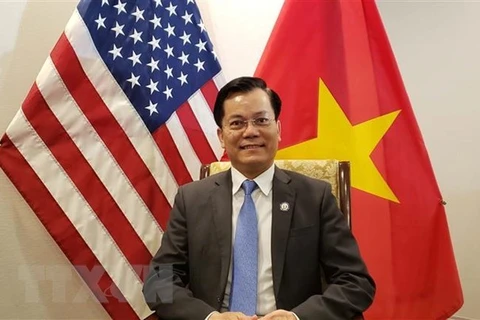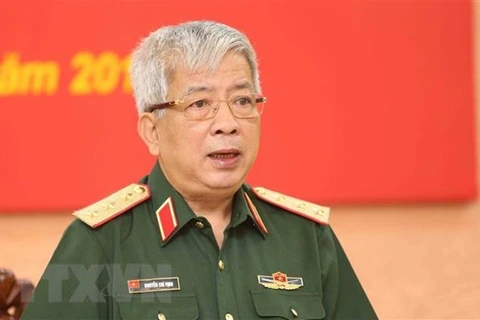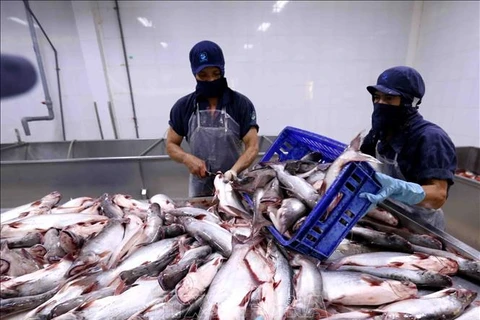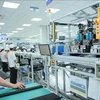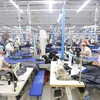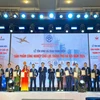Hanoi (VNA) - With huge potential for comprehensive cooperation, Vietnam and the US are boosting two-way trade in a more balanced manner to ensure sustainable development, experts have said.
Commercial Counsellor and head of the Vietnam Trade Office in the US Bui Huy Son said two-way trade rose from 450 million USD in 1994 to 75 billion USD in 2019.
Since the Vietnam-US trade agreement was signed in 2000, Vietnam’s exports to the US have changed considerably, moving from apparel and leather and footwear to agro-fisheries.
Shipments of apparel went up 24 percent last year, footwear 11 percent, mobile phones and spare parts 15 percent, computers and electronics 10 percent, and wooden furniture 9 percent.
Ten commodities earned over 1 billion USD from exports to the US, including apparel, with 14.8 billion USD, mobile phones and spareparts 8.8 billion USD, footwear 6.6 billion USD, and wooden furniture 5.3 billion USD.
The Ministry of Industry and Trade (MoIT) has also actively directed the implementation of an action programme towards harmonious and sustainable trade between the two countries.
Vietnam will import more from the US, in particular energy, farm produce, pharmaceuticals, and machinery and equipment for production and daily use.
Deputy Minister of Industry and Trade Do Thang Hai said recent changes to global supply chains have resulted in Vietnam becoming the 27th largest importer and the 16th largest trade partner of the US.
The US also wants to import products where Vietnam possesses strengths, such as farm produce, apparel, leather and footwear, machinery, and electronics. Vietnam, meanwhile, has demand for high-tech equipment, telecommunications, and farm produce from the US.
With GDP growth of nearly 7 percent each year and a population approaching 100 million, Vietnam is viewed as a promising market for US enterprises in health care, education, telecoms, retail, finance-banking, and energy.
Some 130 countries and territories are now investing in Vietnam, with a combined registered capital of more than 340 billion USD. The US has 900 valid projects worth over 9 billion USD.
Due to the impact of COVID-19, a number of US companies plan to move their investment from other regional nations to Vietnam.
US enterprises are also looking to export more LPG to Vietnam.
Speaking highly of the Vietnamese Government’s efforts to improve administrative reforms and the business climate, President and CEO of the US-ASEAN Business Council Alexander C. Feldman suggested that Vietnam further enhance transparency regarding procurement, bidding, and foreign trade, thus creating a legal environment conducive to innovation and the digital economy.
Minister of Industry and Trade Tran Tuan Anh called on businesses to grasp the commitments made in free trade agreements between Vietnam and major markets, especially those relating to tariff incentives and rules of origin.
He said the MoIT welcomes US enterprises to conduct long-term business in Vietnam and cooperate with Vietnamese partners in hi-tech agriculture, clean technology, and biotechnology, thus helping Vietnam deeply penetrate into regional and global supply chains.
The ministry has also come up with major schemes to improve the competitiveness of exports, he said, particularly industrial and processed products, which also helps Vietnam join supply chains.
Enterprises should outline effective business strategies to navigate the US market, contributing to further tightening Vietnam-US trade ties in the future, the minister added./.
Commercial Counsellor and head of the Vietnam Trade Office in the US Bui Huy Son said two-way trade rose from 450 million USD in 1994 to 75 billion USD in 2019.
Since the Vietnam-US trade agreement was signed in 2000, Vietnam’s exports to the US have changed considerably, moving from apparel and leather and footwear to agro-fisheries.
Shipments of apparel went up 24 percent last year, footwear 11 percent, mobile phones and spare parts 15 percent, computers and electronics 10 percent, and wooden furniture 9 percent.
Ten commodities earned over 1 billion USD from exports to the US, including apparel, with 14.8 billion USD, mobile phones and spareparts 8.8 billion USD, footwear 6.6 billion USD, and wooden furniture 5.3 billion USD.
The Ministry of Industry and Trade (MoIT) has also actively directed the implementation of an action programme towards harmonious and sustainable trade between the two countries.
Vietnam will import more from the US, in particular energy, farm produce, pharmaceuticals, and machinery and equipment for production and daily use.
Deputy Minister of Industry and Trade Do Thang Hai said recent changes to global supply chains have resulted in Vietnam becoming the 27th largest importer and the 16th largest trade partner of the US.
The US also wants to import products where Vietnam possesses strengths, such as farm produce, apparel, leather and footwear, machinery, and electronics. Vietnam, meanwhile, has demand for high-tech equipment, telecommunications, and farm produce from the US.
With GDP growth of nearly 7 percent each year and a population approaching 100 million, Vietnam is viewed as a promising market for US enterprises in health care, education, telecoms, retail, finance-banking, and energy.
Some 130 countries and territories are now investing in Vietnam, with a combined registered capital of more than 340 billion USD. The US has 900 valid projects worth over 9 billion USD.
Due to the impact of COVID-19, a number of US companies plan to move their investment from other regional nations to Vietnam.
US enterprises are also looking to export more LPG to Vietnam.
Speaking highly of the Vietnamese Government’s efforts to improve administrative reforms and the business climate, President and CEO of the US-ASEAN Business Council Alexander C. Feldman suggested that Vietnam further enhance transparency regarding procurement, bidding, and foreign trade, thus creating a legal environment conducive to innovation and the digital economy.
Minister of Industry and Trade Tran Tuan Anh called on businesses to grasp the commitments made in free trade agreements between Vietnam and major markets, especially those relating to tariff incentives and rules of origin.
He said the MoIT welcomes US enterprises to conduct long-term business in Vietnam and cooperate with Vietnamese partners in hi-tech agriculture, clean technology, and biotechnology, thus helping Vietnam deeply penetrate into regional and global supply chains.
The ministry has also come up with major schemes to improve the competitiveness of exports, he said, particularly industrial and processed products, which also helps Vietnam join supply chains.
Enterprises should outline effective business strategies to navigate the US market, contributing to further tightening Vietnam-US trade ties in the future, the minister added./.
VNA

